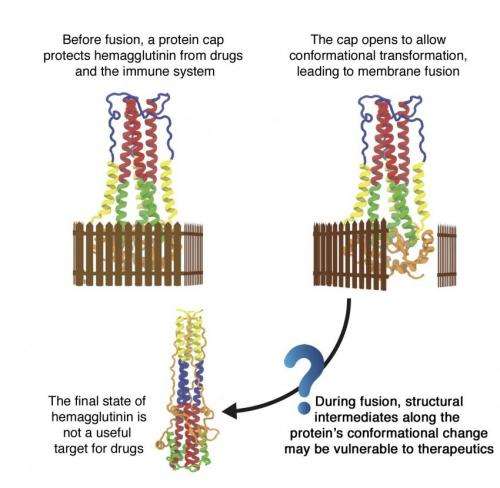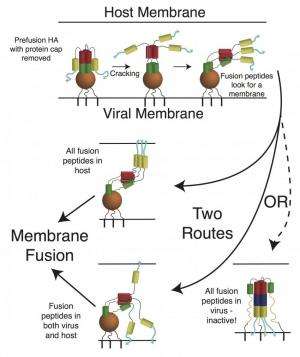Researchers uncover clues to flu's mechanisms

A flu virus acts like a Trojan horse as it attacks and infects host cells. Scientists at Rice University and Baylor College of Medicine have acquired a clearer view of the well-hidden mechanism involved.
Their computer simulations may lead to new strategies to stop influenza, perhaps even a one-size-fits-all vaccine.
The discovery detailed this week in the Proceedings of the National Academy of Science shows the path taken by hemagglutinin, a glycoprotein that rides the surface of the influenza virus, as it releases fusion peptides to invade a host cell.
The release mechanism has been the subject of many theories, but none have explained experimental observations as well as the new work led by biophysicist José Onuchic at Rice and biochemists Qinghua Wang at Baylor and Jianpeng Ma, who has a joint appointment at the two institutions.
The Rice-Baylor team applied protein-folding algorithms developed by Onuchic and his colleagues to analyze how hemagglutinin reconfigures itself as it infects a cell.
Hemagglutinin is completely folded at the start of the process of interest to researchers who study viral infection, Ma said. "It may be the only case known to human beings where a protein starts at a fixed point and literally completely refolds," he said.
Proteins are the molecular motors that spring from DNA and perform tasks essential to life, and they are the prime focus of study for Onuchic and his colleagues at Rice's Center for Theoretical Biological Physics (CTBP). The researchers use their energy landscape theory to determine the path an unfolded strand of amino acids takes as it collapses into a final, functional protein. That involves calculating the energetic preferences of every acid in the chain as well as the influence of the surrounding environment as folding progresses.

When Ma met Onuchic a few years ago, he recognized an opportunity. "I told him there's a very important feature of the viral system that would be ideal for his energy landscape approach." Ma said.
Researchers have long observed hemagglutinin's initial and final structures through X-ray crystallography. But because the change happens so quickly, it has been impossible to capture an image of the glycoprotein in transit. Ma said the key to stopping the flu could be to attack these intermediate structures.
Energy landscape theory predicts how a protein will fold no matter how fast it happens. In the case of hemagglutinin, the unfolding and refolding happens in seconds. During the process, part of the protein "cracks" and releases fusion peptides.
"The fusion peptides are the most important part of the molecule," said Rice postdoctoral researcher and co-author Jeffrey Noel. "The hemagglutinin is attached to the viral membrane, and when these peptides are released, they embed themselves in the target cell's membrane, creating a connection between the two."
"The purpose of hemagglutinin is to poke a hole between the two membranes," Ma said. "They have to fuse so the genetic material will be injected into the human cell."
Hemagglutinin is recognized by polysaccharide receptors on host cells and is absorbed when the cells engulf it. Initially, part of the protein forms a cap that protects the segments inside.
Acidic conditions cause the cap to fall off, and the protein begins to reconfigure itself. "The release of the fusion peptide, which is initially hidden inside hemagglutinin, is triggered by that giant conformational change," Ma said.
"When the cap is on, the whole protein is stable," Noel said. "What we see in the simulation is that the hydrophobic pocket where the fusion peptides are buried is very unstable and wants to crack as soon as the cap comes off."
By using the experimental structural information from X-ray crystallography to approximate the full energy landscape of hemagglutinin, the researchers can now capture a rough picture of the steps involved in its reconfiguration, including the point at which the peptides are released. "We now, for the first time, have mapped out the entire process, going from state A to state B, and the energetics along the way," Ma said.
Ma said frequent mutations to the cap help the virus avoid antibodies; this is the reason people need flu shots every year. But he suspects the inner part of the protein is more highly conserved. "We're targeting the part that the virus cannot afford to change. Therefore, it provides more hope for developing therapeutic agents," he said. Such agents could lead to a universal flu vaccine that would last a lifetime.
He said the membrane fusion mechanism is widely shared among many biological systems, which makes influenza a good model for studying other diseases. "HIV has one. Ebola has one. And it's also shared by intercell transport in the nervous system," Ma said.
He noted the work could not have been done without CTBP, which moved to Rice from the University of California, San Diego, three years ago to take advantage of collaborations with Texas Medical Center researchers – one of Rice's Priorities for the New Century. "This demonstrates a very interesting collaboration between TMC and Rice," Ma said. "We're very happy with that."
More information: Xingcheng Lin, Nathanial R. Eddy, Jeffrey K. Noel, Paul C. Whitford, Qinghua Wang, Jianpeng Ma, and José N. Onuchic. "Order and disorder control the functional rearrangement of influenza hemagglutinin." PNAS 2014 ; published ahead of print July 31, 2014, doi:10.1073/pnas.1412849111. www.pnas.org/content/early/201 … /1412849111.abstract



















